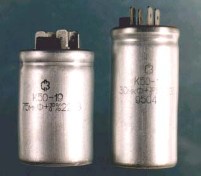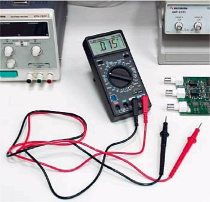Categories: Practical Electronics, Electrician Secrets
Number of views: 161986
Comments on the article: 6
How to identify capacitor malfunction
 Loss of performance capacitorsmay occur due to:
Loss of performance capacitorsmay occur due to:
i) a short circuit inside it;
b) a chain break inside it;
c) increase in leakage current;
d) decrease in capacity.
An inoperative capacitor can be determined using an ohmmeter, a special device for measuring capacitance, or a test circuit.
For a rough check of the suitability of capacitors, it is recommended to control them using resistance meters (ohmmeter, combined instrument - multimeter).
The verification procedure is as follows:
1) one of the terminals of the capacitor should be separated (soldered) from the circuit;
2) the measuring device is configured to measure in the range of tens and hundreds of kilo-ohms or even megaohms;
3) are applied to the terminals of the capacitor multimeter probes.
In this case, for capacitors of large capacity from several tens to several thousand microfarads, the initial throw of the arrow of the device to “zero” (at the moment of passage of the maximum charge current) with the subsequent deviation of the arrow to the label “infinity” will be characteristic;
4) an ohmmeter reading of at least 100 kOhm will correspond to a satisfactory condition of the dielectric of the capacitor;
5) if an open circuit occurs in a large capacitor (10 - 100 μF), then the arrow of the device is immediately set to the “infinity” mark;
6) for small capacitors, it is almost impossible to determine the presence of an open circuit with an ohmmeter, since the measuring device will show either a short circuit if an insulation breakdown has occurred, or an infinitely large resistance if the capacitor is in good condition or there is an open.
 If there is a suspicion of a break, such capacitors are usually replaced.
If there is a suspicion of a break, such capacitors are usually replaced.
An open circuit inside the capacitor is determined by means of a measurement circuit consisting of a series-connected capacitor, an alternating current ammeter and a resistor that limits the current through the device.
The circuit is switched on to an AC source, the voltage of which should not exceed 20% of the rated voltage of the capacitor. A lack of current in the circuit indicates an open.
The increase in leakage current is determined by reconnecting the ohmmeter to the capacitor terminals.
At the first connection, the arrow of the device deviates due to the charge current, and then returns to its original position.
If during subsequent connections, repeated with an interval of several seconds, the deviations of the arrow are repeated, this means that the capacitor has an increased leakage current.
The decrease in capacity that occurs most often in electrolytic capacitors, is determined by comparing the nominal capacitance with the actual, measured by means of special bridges or circuits and some types of multimeters.
And here is a reader about the intricacies of testing transistors: How to check the transistor.
See also at e.imadeself.com
:
